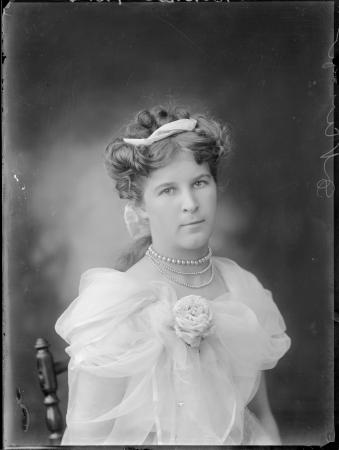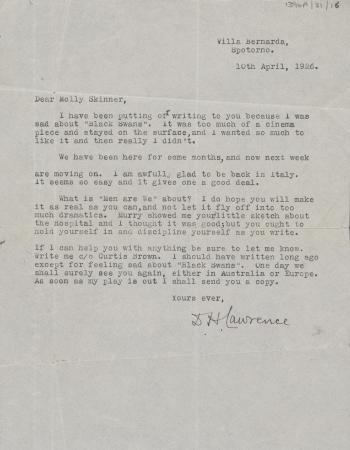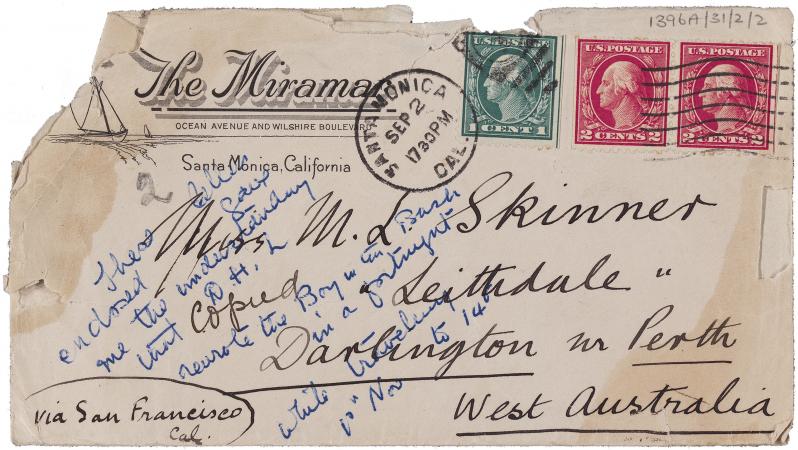Listen as Dr Kate unpacks how and why the State Library has a surprising collection of author D.H. Lawrence letters that were written to WA’s Mollie Skinner.
You can view the letters and papers in the State Library Catalogue.
Recorded live on ABC Radio Perth on 23 July 2021.
Transcript
BEGINNING OF INTERVIEW
Christine: When was the last time you sent a hand written letter? I often wonder whether emails will be treasured as much by our State’s Library. But I tell you what, they have got a range of oddities but this collection of letters from one of the greatest novelists in modern history definitely had me surprised. Let’s see, author D H Lawrence, best known for the works The Rainbow, Sons and Lovers, Women in Love. They are just some of them. They are revered writer letters. They’ve ended up in WA somehow.
Battye Historian from the State Library. Dr Kate Gregory joins me to discuss.
Hello Kate!
KG: Hi Christine, how are you?
Christine: I’m very well. Now usually we speak from... we speak about people who are from WA but in this instance it’s somebody who fell in love with WA. Is that right?
KG: Almost. That’s almost right. I think, I think this is the thing. It is an oddity. It is so extraordinary to think that at the State Library we have these 17 letters written from
D H Lawrence to Mollie Skinner, who was his collaborator on one of his books The Boy in the Bush. So, there’s a bit of a long winded story but how on earth did D H Lawrence meet Mollie Skinner? How did he come to Western Australia? I think these are questions that I had in my first found... found out about D H Lawrence’s connections with WA.
Christine: Where is he from Kate? Where, what do we know about him?
KG: So D H Lawrence, yes, ok so apart from being one of the most influential writers of his generation and the kind of literary pioneer. He was known I guess as a writer that sort of really pushed the moral and social boundaries and his novel in particular Lady Chatterley’s Lover that was published in 1928 was perceived as very explicit in nature and very controversial and it was heavily censored and subject to a great deal of controversy. So, I guess that kind of reputation is still remaining but he was clearly one of the great kind of literary figures of the 20th century.
So, born in 1885 in England, the son of a coal miner. It’s an amazing story and then an extraordinary writer. He didn’t live for very long either. He died at the age of 45 in 1930 from tuberculosis in France. But look he and his wife Frieda had kind of left England. He was absolutely despairing of his... I guess, at that point, his reputation as a writer. People really didn’t respect what he was doing and he was kind of despairing, so in 1919 they actually left England; Frieda and Lawrence left England and they never lived there again in fact and they moved around and they went... they lived in Italy in Sicily. They lived in Australia. They lived in New Mexico, in France. They stayed in Sri Lanka before they got to Australia.
Christine: [Sigh] What a life!
KG: They really...they were seeking...but I think this is the thing. They were kind of hmm… and he talked about it as a kind of an exile and they were looking for sort of something new in the new worlds of particularly Australia and the Americas. So anyway, look he was on a ship with his wife Frieda. They were on a ship from Italy to Sri Lanka and they met a West Australian woman by the name of… let me get this name because it is quite an amazing name. She was one of the leading socialites in Australia and her name was Pussy Jenkins. Mrs Pussy Jenkins. So that’s how she was known.
Christine: Sounds like a nursery rhyme character.
KG: Well, it does, it’s incredible. She was the daughter of the late Septimus Burt who was once Western Australia’s Attorney General. But anyway, they got along really well on this ship and she urged them to travel to Australia, go on to Australia, you know, and Lawrence at this time had this fascination with the idea of renewal and regeneration in Australia and so, he didn’t need a lot of convincing and so, two months after spending some time in Sri Lanka, they decided to set sail for Australia and they arrived in Fremantle, in May 1922.
Christine: May 1922.
KG: And they met...
Christine: Ok.
KG: Yes, 1922. So, he arrives in Fremantle with his wife and then they really don’t have any plan for what they are going to be doing. Just kind of in search of new places and they liked the idea that it would be cooler than Sri Lanka.
Christine: Yes.
KG: And they were met at the wharf by Pussy and then they were... they stayed a couple of days in a hotel which was... they found exorbitantly expensive. I think there’s a quote with
D H Lawrence saying something like, “This is the most expensive hotel I have ever stayed in” [giggles].
Christine: [Laughs]
KG: So, they very quickly were recommended to stay in a wonderful Darlington guest house in the Perth hills…
Christine: Good choice.
KG: Which was owned by Mollie Skinner.
Christine: [Sighs] Aaaahhhh.
KG: And the name, yes, and the name of this guest house was ‘Leithdale’ and so, the Lawrences stayed at Leithdale and this was really only for a couple of weeks and it was during that stay that Lawrence and Mollie Skinner struck up this collaboration and there’s a wonderful kind of anecdote that it was actually Mollie Lucas was in the laundry at Leithdale and sort of over the laundry tub struck up this conversation with D H Lawrence because she was a writer. She was an aspiring writer and she had been a nurse and ... so and look there’s an interesting story there. I’ll tell you a little bit about how Leithdale got started as well, as well as guest house.
Christine: Yes, yes tell me.
KG: But [giggles] ok. So look, so Mollie Skinner she had been a nurse and she had in particular, this is interesting for the current moment, she’d been a nurse during the Spanish flu epidemic in WA, in fact she’d been stationed at Woodman Point as a nurse and caring for people who were suffering from the Spanish flu and so kind of, you know, 1920 there’s a wonderful quote from one of the newspapers at the time, which says some of the returned nursing sisters possessed an enterprise of the right sort and this is Mollie Skinner and so, then it goes on to discuss Darlington. It’s a beautiful, old fashioned, comfortable homestead situated high on the hillside with a wonderful view down and they thought of this as a place of rehabilitation and rest and a few days at Leithdale will provide a tonic for anyone who wasn’t feeling quite up to the mark.
Christine: [Laughs]
KG: But Leithdale was established straight after the impact of the Spanish flu here in WA in 1919 and it was kind of with the view of it being a place of rest and refuge and you know the sort of the bushland and the beautiful setting would help recuperate and restore.
Christine: [Astonishment] Wow.
KG: So, really lovely.
Christine: As a side-note, does it still exist? Does Leithdale still exist?
KG: Leithdale is there. Leithdale the house is still there in Darlington, that’s right and look, I was going to get onto this later, but I’ll get onto it now because the reason why I am so... one of the reasons why I am so interested in this is that as a teenager, my best friend lived at Leithdale. Her family owned Leithdale.
Christine: [Astonishment] Wow!
KG: Yes, and as a young teenager, I remember catching the train with my best friend up to Darlington, up to Leithdale to stay the weekend and it was gorgeous. I mean it’s a beautiful old rambling house with amazing setting, bush setting and high up on the hill looking over incredible views and...
Christine: Yes, and did you feel rested afterwards? Did it have those healing powers?
KG: [Laughs] No, I said no. I think at that time it was all kind of ghost stories and ‘is it haunted?’ and but I did.. .they knew about the connection with D H Lawrence and there’s this kind of this mythology, this mythology around the house. It was just great.
Christine: You are...
KG: So that was a really...
Christine: ...Literally the best person to tell this story.
It’s 20 minutes past 2 on ABC Radio, Perth.
My guest is Dr Kate Gregory. We’re talking about D H Lawrence and Mollie Skinner and Leithdale house in the Darlington Hills.
I should also tell you just very quickly, we’re waiting on a press conference from the Premier. He has not stepped up to the podium yet so as soon as he does, I’ll bring you that audio and the Prime Minister is also due to hold a press conference at 2.30 following National Cabinet. I’ve got that for you coming.
There’s also a crash on the Kwinana Freeway south bound after Manning Road as you told me on the text line; thank you. The two right lanes are blocked. Traffic is all the way back to the city, so allow extra time to get home or maybe use Stirling Highway or the Causeway in Canning Highway.
Ok, back to this.
So, what can we gleam from these letters Kate?
KG: Yes, so, back to the main kind of point of it [giggles]. So really, I think that Mollie and
D H Lawrence had to kind of have these conversations and he encouraged her to write a book about the, based on the life of her brother and s,o she didn’t need too much encouragement. She was an avid, aspiring writer already and so these letters are their correspondence about the manuscript and in it basically, she sends D H Lawrence the manuscript and at that time it’s titled The House of Ellis and he comments on it and says that he’d like to collaborate with her and so, he does and the book is later published as The Boy in the Bush.
Christine: Right.
KG: So it’s a really, excuse me, I just have to cough. Hang on one minute.
Christine: Go for it, no, you do what you need to do.
I am speaking to Dr Kate Gregory about D H Lawrence.
So The Boy in the Bush. And I have not read The Boy in the Bush. What is it about Kate?
Still coughing, that’s fine.
He visited Perth a few times I’m told and we are going to talk about his impressions.
Oh she’s dropped off the line, oh, no, Dr Kate Gregory is not there anymore and I can’t tell you the rest of this story because I’m not the Battye Historian, but I think we found her. I can tell you the incorrect history but that’s no good.
Welcome back Kate.
KG: Sorry about this Christine, I don’t know what happened. Dropped off.
Christine: That’s ok.
KG: In the middle of a cough.
Christine: That was a very good cough, just quietly.
KG: Sorry.
Christine: So, he visited Perth a few times. What did he make of Western Australia?
KG: Look, there’s a lovely quote that I would like to read because this kind of shows you how he was encountering the landscape. He found, the landscape for him was just fascinating and there is a wonderful quote where he describes the foreignness of it to him and let me just find it. He says, “The land is here, sky high and blue and new as if no one had ever taken a breath from it and the air is new, strong, fresh as silver and the land is terribly big and empty; still uninhabited. It is too new you see, too vast. The people who are here are not really here. The land has a force dimension and the white people swim like shadows over the surface of it.”
So that’s just an amazing quote. You can see, obviously he’s not directly referencing Aboriginal people who were living here. The land was indeed inhabited but he’s aware of it and he’s talking about really how foreign it is and how unknown and it’s kind of in some ways unknowable it is in his eyes.
Christine: Oh yes, wow.
KG: Yes.
Christine: So what does this collection tell us about WA history? Why is it an important one to talk about?
KG: Yes, it is because it shows how WA was connected to the world. It shows how, we kind of can tend to have a really kind of parochial idea of how, Perth’s development, but Perth was a place connected to the global world and there were a range of really influential people who came here and collaborated and produced creative work and I just think that it is kind of surprising that we’ve got these letters of course, but at the same time it’s actually indicative of the fact that Perth was actually globally connected.
Christine: Yes, yes that’s very true.
It’s so fascinating. You know, I was reflecting on this story today just as we were writing up the scripts and I thought to myself, will emails ever be considered like...
KG: Oh, definitely.
Christine: ...letters and I ask people whether they’re still writing letters and I’ll read you some texts in just a moment, but, but are they and can they be as easily? How does it work?
KG: Well, look absolutely and I mean that is something that the State Library is very proactively grappling with and that is the collection of digital content, digital material, digitally born, digital material. So everything from blogs to letters to emails that are digital. It’s all really important for the future so yes, indeed; the State Library is grappling with collecting the digital.
Christine: That’s good to know.
Kate, this was a really interesting story. Thank you so much for alerting us to the history of
D H Lawrence and Leithdale as well. I’m going to go and have a look at a photo of it and we’ll chat to you again in a fortnight’s time.
KG: Ok, thanks so much Christine.
Christine: That’s Dr Kate Gregory, Battye Historian, talking about this amazing treasure trove of letters from author D H Lawrence born in 1885 in England, died of tuberculosis in 1930. He only lived for 45 years but collaborated with Mollie Skinner who is a WA author and they put together The Boy in the Bush.
END OF INTERVIEW



